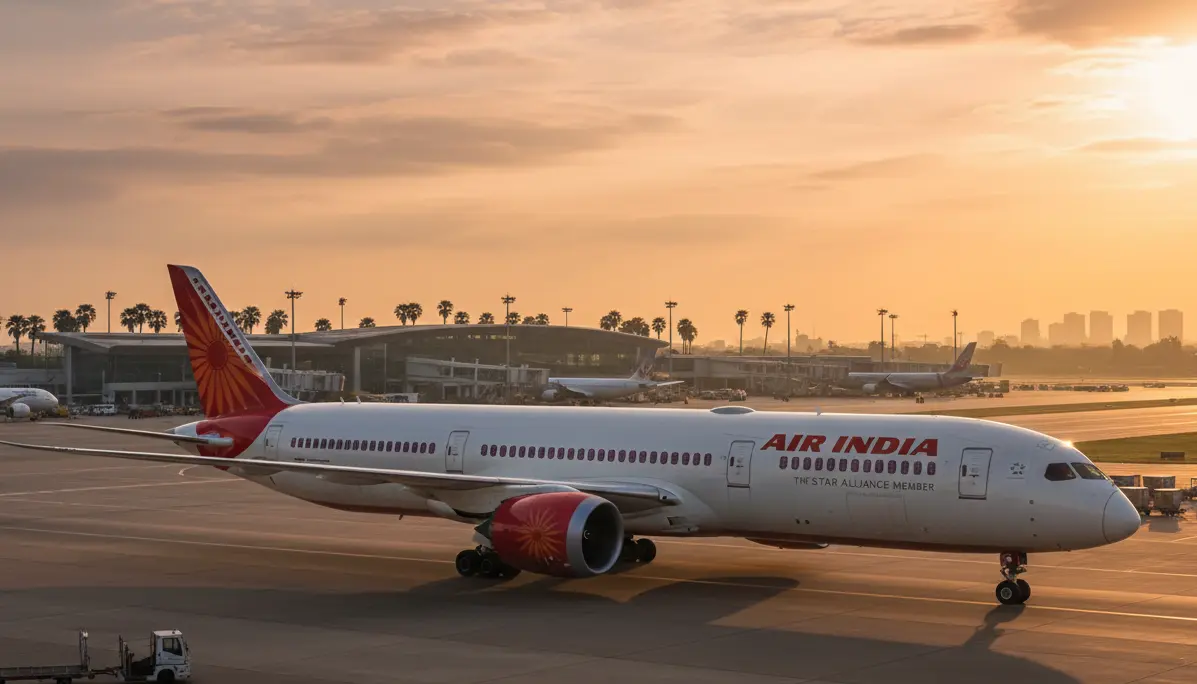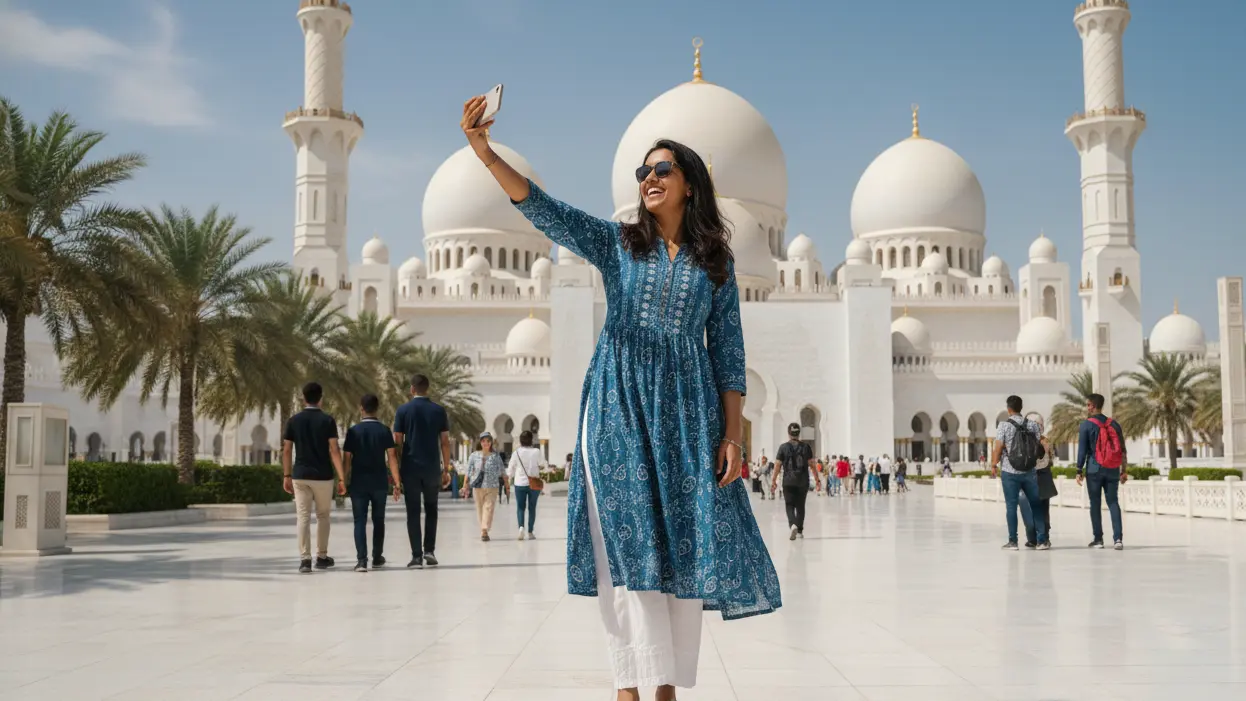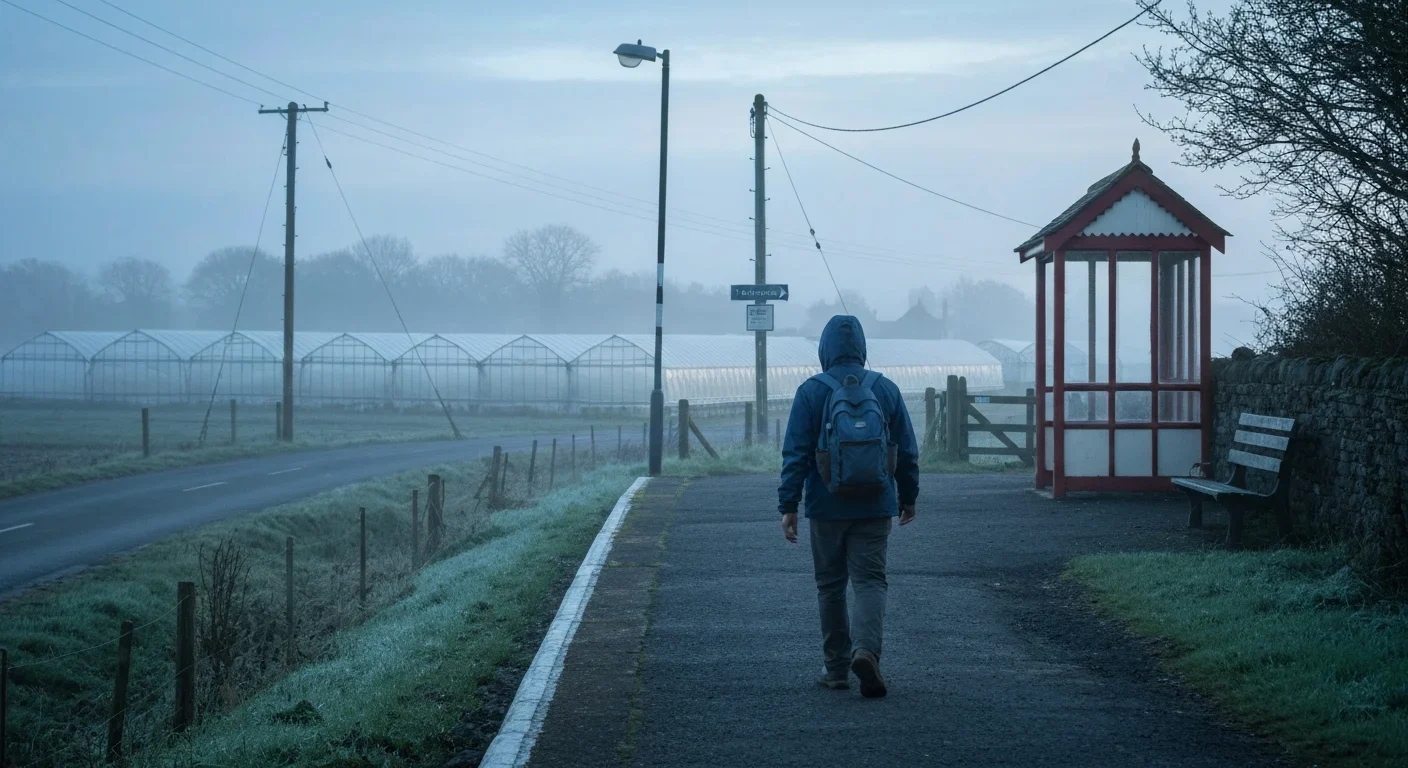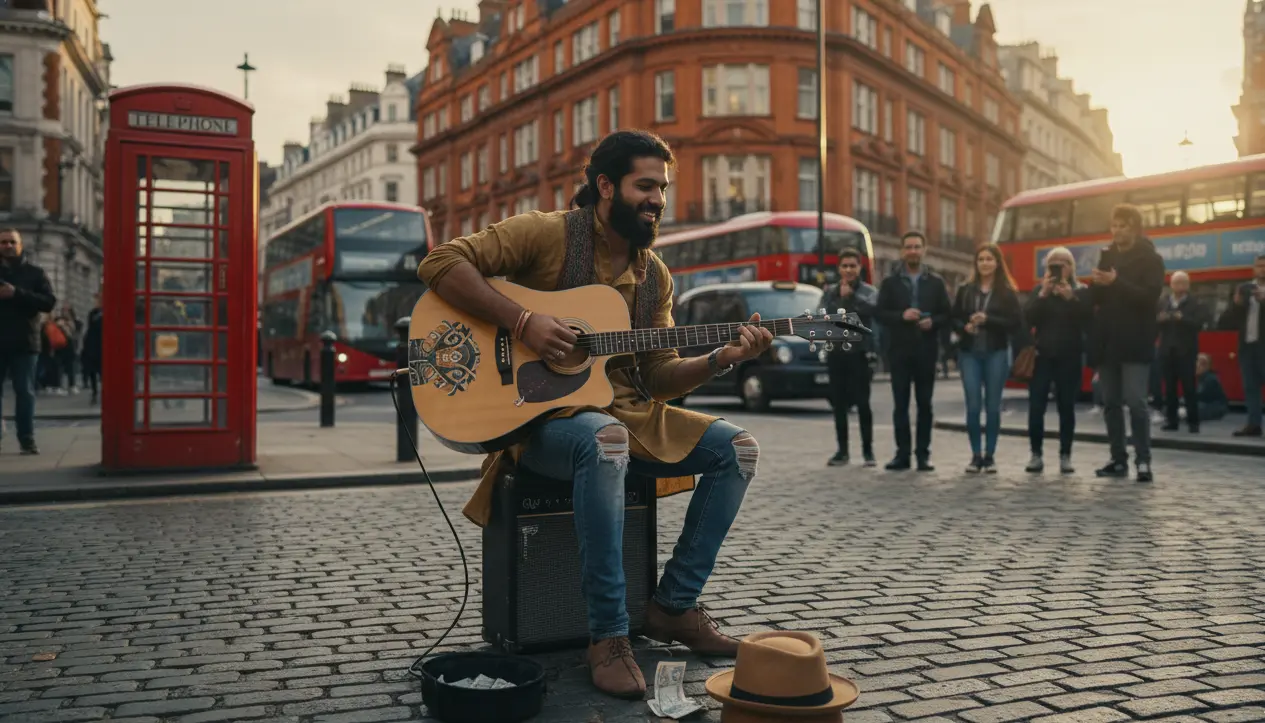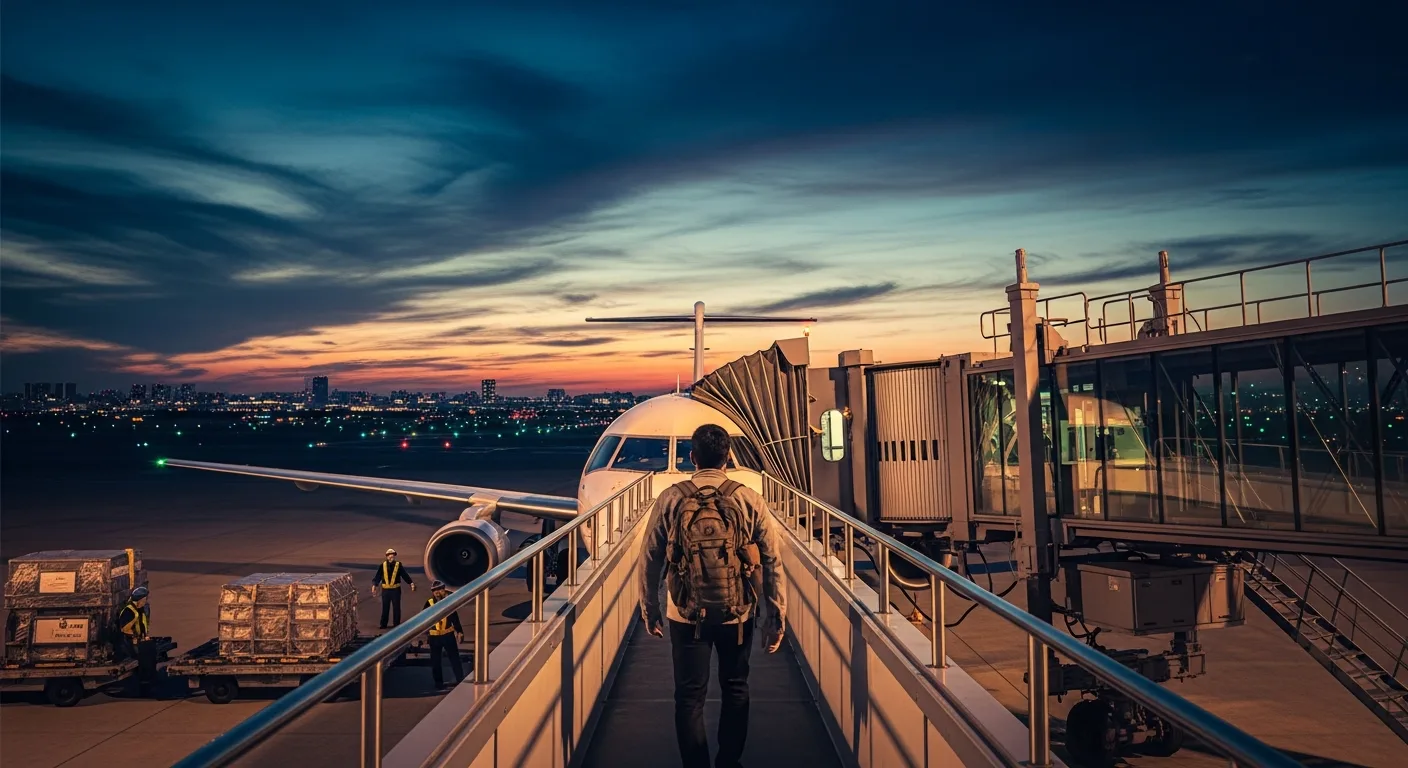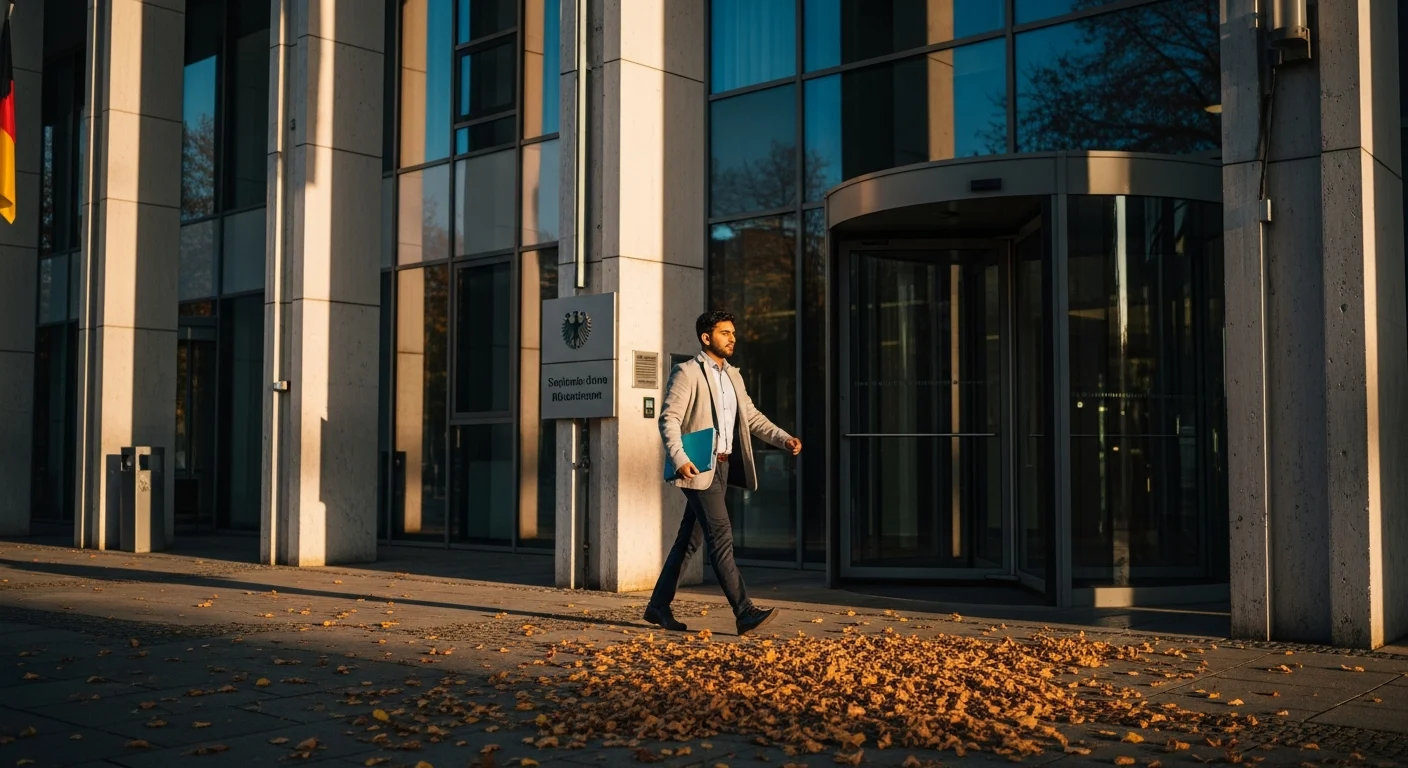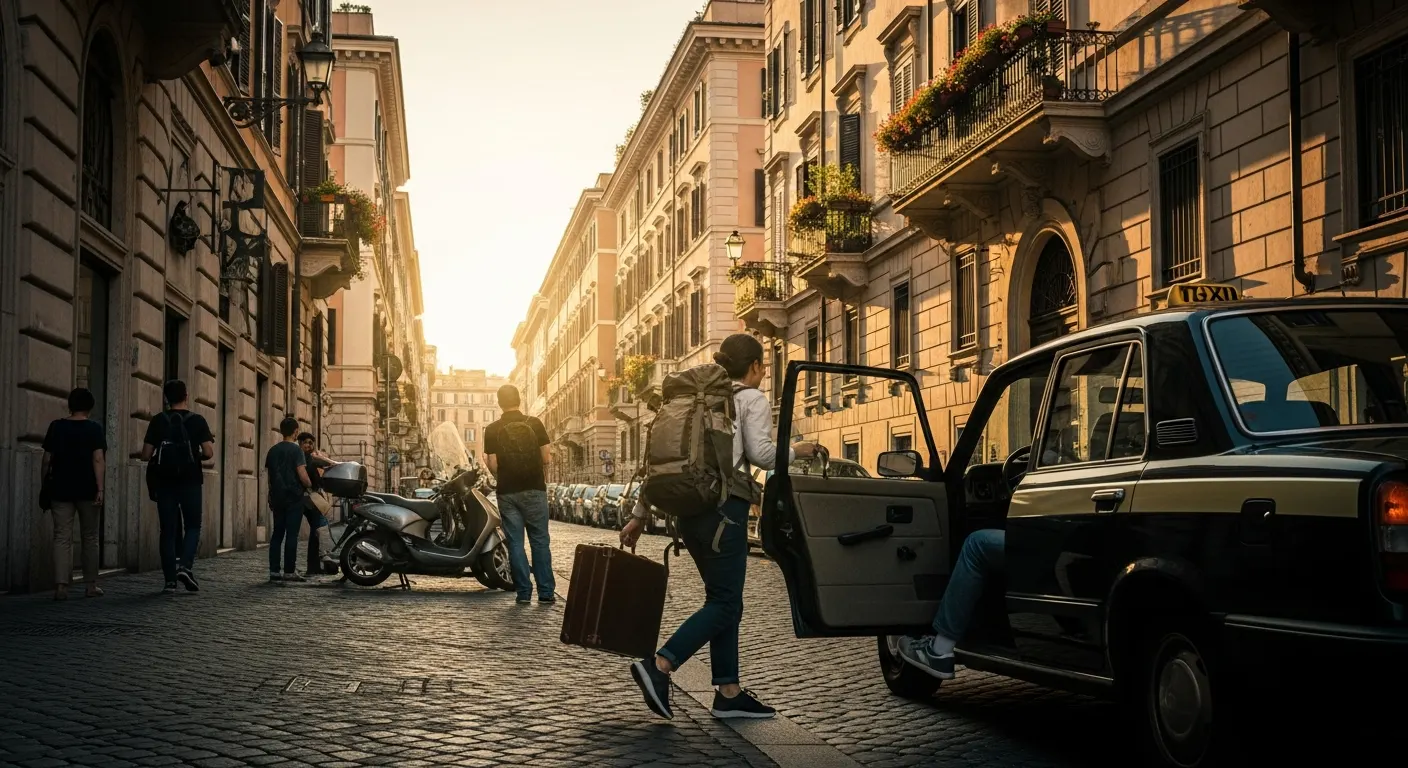How Can A Dummy Ticket Save You From F1 Visa Rejection?
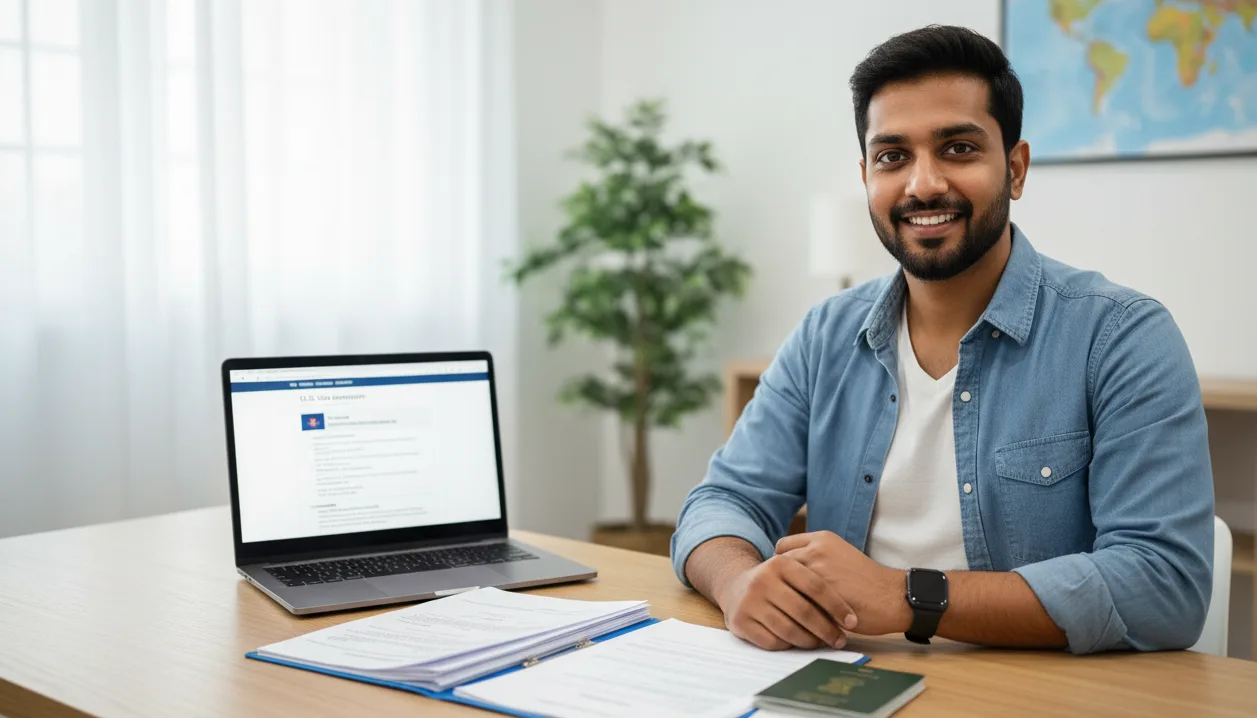
Dummy Ticket for F1 Visa Interview — Avoid Rejection With This Simple Step
Getting ready for your F1 visa interview can feel like a mix of excitement and nerves. You’ve gathered your I-20, paid the SEVIS fee, organized your financial proofs, and practiced your answers. But here’s something many students overlook—how your travel plan can quietly influence your visa outcome. A dummy ticket provides verifiable proof of onward travel, strengthening your application from the start. For more tips, check our FAQ or explore blogs on visa preparation.
While you aren’t required to show a booked ticket, visa officers often notice when an applicant’s travel details look vague, unrealistic, or fake. It raises doubts about how genuinely prepared you are to study in the U.S. That’s where a real, verifiable dummy ticket can make a difference. It shows that you’ve planned your journey carefully, without wasting money on a full ticket. Learn about our story in the About Us section.
A dummy ticket for F1 visa is a verifiable flight reservation that shows your confirmed travel intent to the US without purchasing a real airline ticket. It contains a genuine Passenger Name Record (PNR), airline name, and travel dates that the US Embassy can verify directly. For Indian students applying for the F1 visa, presenting a valid dummy ticket signals clear travel plans and financial responsibility — two key factors officers assess during visa interviews. DummyFlights.com issues embassy-approved dummy tickets with real PNRs, helping applicants demonstrate genuine intent while avoiding costly last-minute bookings or visa rejection risks due to missing documentation.
Last updated: October 2025 — verified for US F1 student visa documentation and Indian embassy travel proof requirements.
Let's explore how something as simple as a dummy ticket can help protect your F1 visa application from unnecessary rejection. Get your verified travel proof in minutes—start your dummy ticket booking today.
Why Visa Officers Care About Your Travel Plans More Than You Think
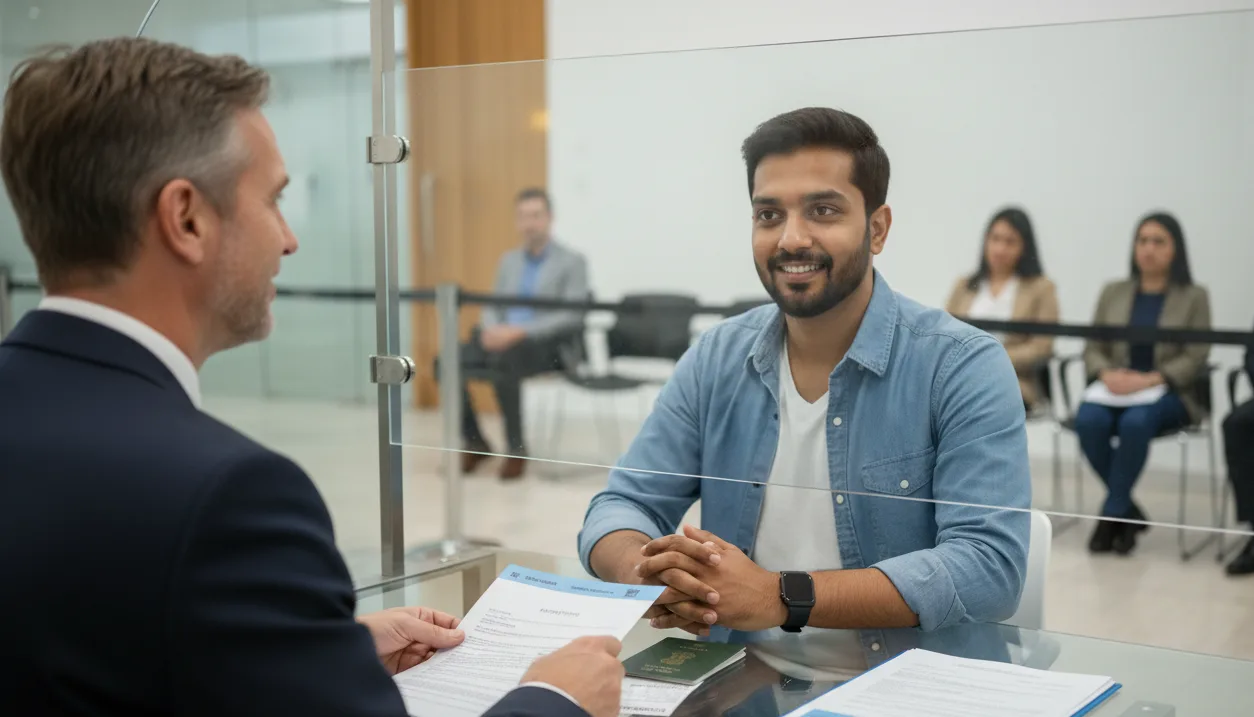
You might assume that as long as your documents and finances check out, your F1 visa is safe. But visa officers aren’t just reviewing paperwork—they’re reading you. They’re trying to decide, in just a few minutes, whether you genuinely intend to study and return or if you’re uncertain about your plans. That’s why even something as small as a travel reservation can send a powerful message about how serious and organized you are. For official U.S. visa guidelines, refer to the U.S. Department of State.
A lot of Indian students get caught off guard here. They walk into the interview with a strong academic record but weak travel documentation—vague itineraries, unverifiable flight PDFs, or simply saying, “I’ll book later.” While it may sound harmless, this lack of clarity can make a visa officer pause and question how committed you are to your stated plans.
Let’s unpack why your travel details matter more than most applicants realize. Make your visa application stronger with a real, embassy-verifiable document—book a dummy ticket now.
Stepping Into The Visa Officer’s Shoes
When a U.S. visa officer speaks to you, they’re looking for three main things: authenticity, clarity, and intent. They don’t need you to have purchased a confirmed air ticket—but they want to see that you’ve thought through the when, how, and why of your journey.
Every confident applicant signals preparation. A verifiable dummy ticket that aligns with your university’s reporting date tells the officer, “I know when I’m going, I’m prepared for my studies, and I’ve got a plan.”
Now imagine the opposite scenario. You mention you’ll “probably fly sometime in August,” but your I-20 start date is August 10. That one vague answer can instantly trigger a chain of doubts: Are you serious about joining on time? Have you finalized your plans? Or worse, are you uncertain about returning after your course?
That’s the lens through which they evaluate your case.
The Subtle Red Flags That Unclear Travel Plans Create
Visa officers handle thousands of student applications every month. Over time, they recognize patterns—especially among applicants who end up rejected under Section 214(b). One of the earliest warning signs? Unclear or fake-looking travel proof.
When an officer reviews your DS-160 and I-20 but finds no matching travel evidence, it raises suspicion. Here’s why:
- It suggests a lack of readiness. If your course starts soon and you haven’t planned your journey, it might look like you’re not taking the process seriously.
- It hints at inconsistency. Your travel timeline should logically fit your I-20 start date and SEVIS payment date. If it doesn’t, something feels off.
- It questions your intent. Officers know that genuine students prepare every part of their trip carefully. A missing or unverifiable itinerary can make it seem like you’re not sure about your own plans.
Even if you have genuine reasons—like waiting for visa approval before buying a ticket—officers can only judge what they see. And if your travel proof looks fake or incomplete, they have little reason to give you the benefit of the doubt.
Why Section 214(b) Is Every Student’s Biggest Threat
Most F1 visa denials in India fall under Section 214(b), which means the officer wasn’t convinced that the applicant’s intent to study (and eventually return) was genuine. This section doesn’t accuse you of lying—it simply means the officer didn’t see enough evidence of credibility.
Think of it as a “benefit of the doubt” decision. Your documents, answers, and body language together build that trust. And while travel plans may seem minor, they often tip the balance.
Here’s an example:
Two students, both admitted to U.S. universities, appear for their F1 interviews.
- Student A has a verifiable dummy ticket that shows a flight two weeks before orientation, aligned with her I-20 start date. Her response: “Yes, I’ve made a reservation for August 2 with Qatar Airways.”
- Student B simply says, “I’ll book after I get my visa.”
Guess who looks more prepared? Student A’s attention to detail subtly reassures the officer that she’s ready, organized, and genuinely planning her education abroad.
How Genuine-Looking Proof Earns You Instant Credibility
Let’s be honest—visa officers can spot a fake or low-effort document in seconds. Many applicants still bring printouts from “free dummy ticket generators” or screenshots of “reservations” that don’t exist in airline databases. Those files might fool your friends, but not a trained officer.
A verifiable dummy ticket, on the other hand, comes with a real, checkable PNR (Passenger Name Record). Officers can confirm its authenticity instantly using the airline’s system. That one small detail can change their impression from doubtful to confident.
This isn’t about showing off; it’s about removing unnecessary doubts. Every time you eliminate a potential red flag, you make the officer’s decision easier—and in your favor.
Small Preparations That Reflect Big Intent
When reviewing applicants, officers pay attention to consistency. They expect your documents to “talk to each other.” For example:
- Your I-20 lists your program start date.
- Your SEVIS fee receipt shows timely payment.
- Your dummy ticket should reflect a logical travel window before that start date.
When these timelines make sense together, your profile feels coherent and credible. And credibility, more than anything else, drives visa success.
A verifiable dummy ticket helps connect the dots—showing that your travel plans match your academic and financial readiness.
Indian Students Often Underestimate This Detail
Many first-time applicants from India tend to focus entirely on answering common interview questions or showing enough funds. That’s important, but remember: officers aren’t checking if you’re wealthy—they’re checking if you’re ready.
Submitting a clear, checkable flight reservation shows you’ve thought ahead. You’re not just reacting to the process; you’re managing it. That proactive mindset often separates approved cases from rejections.
A Simple Step That Strengthens Your Whole Profile
A verifiable dummy ticket doesn’t guarantee a visa approval—but it eliminates a common and avoidable reason for rejection. It signals intent, planning, and honesty, three traits every officer looks for.
If you think of your F1 interview as a story, every document you submit is a chapter that should make sense together. Your dummy ticket is one of the easiest ways to ensure your story reads clearly and convincingly.
So, while many applicants still walk into interviews saying, “I’ll book my ticket later,” you’ll walk in prepared—with a real, verifiable itinerary that speaks for you before you even open your mouth.
That difference, though small on paper, often shapes how confidently your interview unfolds—and how confidently the officer stamps your visa.
Common F1 Visa Rejection Triggers You Can Avoid With A Clear Travel Plan
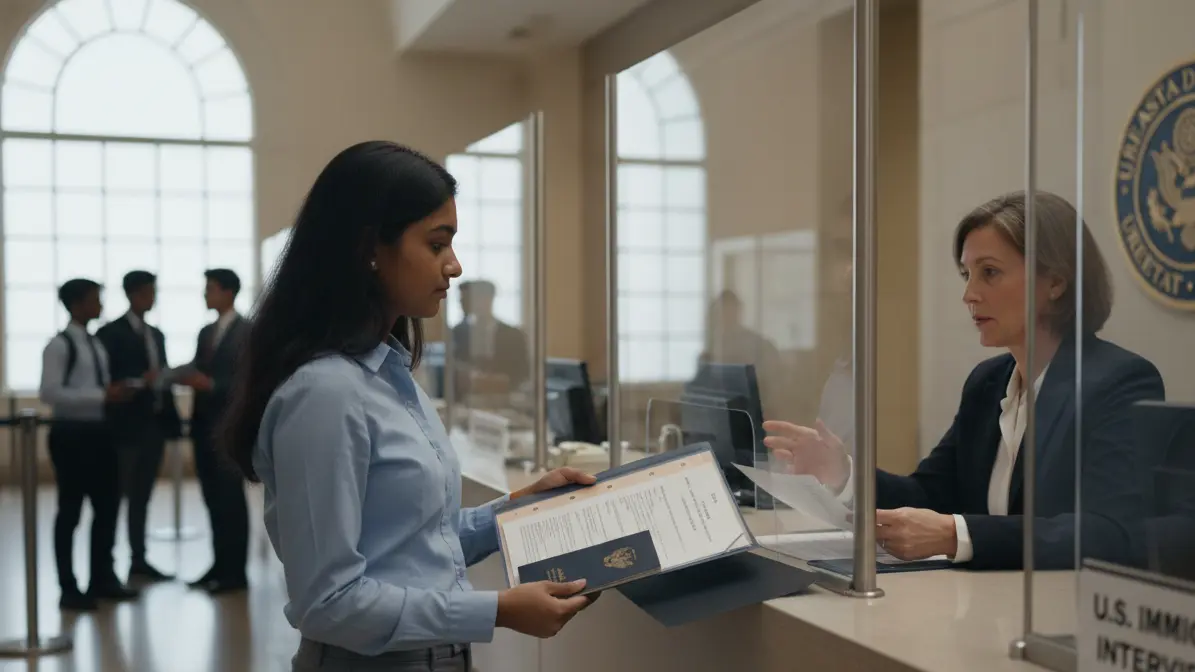
Even the most qualified students can face F1 visa rejection. Sometimes, it’s not because of academics or finances—it’s because of subtle details that make the officer doubt your intent or readiness. Your travel proof is one of those small details that can quietly sway the decision.
If your itinerary doesn’t look genuine, consistent, or logical, it can raise questions that hurt your case. Let’s explore the most common rejection triggers linked to unclear or weak travel documentation—and how you can avoid them. Avoid the stress of last-minute flight proofs and book a dummy ticket instantly online.
“I’ll Book Later” — The Line That Often Backfires
Many Indian students walk into their F1 interview thinking they can simply tell the officer they’ll book their ticket after approval. While that’s technically allowed, it doesn’t always sound convincing.
Here’s why: visa officers have minutes to assess your intent. When you say “I’ll book later,” you might think you’re being practical, but what they hear is uncertainty. It signals that your travel plan isn’t clear yet—which makes your overall preparation seem incomplete.
Instead, a verifiable dummy ticket gives you a balanced middle ground. You’re not risking money on a full ticket, yet you’re showing that you’ve planned when and how you’ll travel. That simple difference can completely change the tone of your interview.
Suspicious Or Unverifiable Flight Proofs
In recent years, officers have seen an increase in applicants submitting PDFs or screenshots that don’t exist in airline systems. Some students unknowingly use free “dummy ticket” websites that generate fake bookings. These are easy to spot.
When officers run a quick check and the PNR doesn’t show up on the airline’s website, it creates instant doubt. Even if the rest of your documents are strong, this one error can make your entire case look suspicious.
Here’s what typically happens:
- The officer sees a questionable ticket and flags the inconsistency.
- They begin to question the credibility of other documents.
- Once trust is lost, it’s hard to recover during the interview.
That’s how rejections happen—not because of intent, but because of perception.
A real, verifiable dummy ticket solves this. It’s issued through actual airline systems and can be confirmed instantly online. That transparency is what officers trust.
Mismatched Dates And Details That Don’t Add Up
Even if your ticket is genuine, inconsistencies between your travel plan and your I-20 can trigger confusion. Officers expect your itinerary to align logically with your academic schedule.
For example:
- Your I-20 says your course begins on August 20, but your ticket shows arrival on September 5.
- Or, your SEVIS fee was paid in early June, but your ticket suggests you’ll travel in late October.
These details may look small, but to a visa officer, they signal a lack of coordination—or worse, that you’re not serious about arriving on time.
The smart approach is to book a dummy ticket that matches your I-20 timeline—typically departing 10–15 days before your program start date. That window gives you enough time for orientation, jet lag recovery, and settling into student life.
Overconfident Or Vague Interview Responses
Another subtle yet common mistake is how applicants talk about their travel plans during the interview. Statements like “My agent handled it,” or “I haven’t decided yet,” sound casual but can erode credibility.
Visa officers expect applicants to speak for themselves, confidently and clearly. Even if an agent helped you, your answers should reflect ownership.
Here’s how the difference sounds in practice:
- ❌ Weak response: “I think my agent booked it. I haven’t checked.”
- ✅ Strong response: “Yes, I’ve made a verifiable reservation for August 5 with Lufthansa, aligned with my I-20 date.”
The second answer doesn’t just sound better—it reflects planning, responsibility, and confidence. Those are the qualities officers associate with genuine students.
Submitting Fake Or Edited Bookings—A Costly Shortcut
Some applicants, in an attempt to save money, edit old PDFs or create fake itineraries using free templates online. This is a major mistake. Consular officers can instantly verify flight data through their internal systems.
When they catch even a small sign of document tampering, it’s treated as misrepresentation, not a minor oversight. That can lead to immediate rejection and may affect future visa applications.
Remember, honesty and verifiability always win. A real dummy ticket costs little, but it protects your reputation and credibility—two things you can’t rebuild easily after a rejection.
Missing The Psychological Advantage Of Preparation
There’s another underrated aspect here: confidence. When your documentation is in order, it shows in how you present yourself. Having a clear, legitimate travel plan helps you walk into the interview knowing you’ve covered every angle.
Officers notice that calm, collected demeanor. In contrast, when applicants scramble through their answers or hesitate when asked about travel details, it hints at poor preparation.
Think of your dummy ticket as more than a piece of paper—it’s part of your mindset. It lets you say, truthfully and confidently, “Yes, my reservation is ready, and my travel aligns with my course dates.” That clarity instantly sets a professional tone.
Overlooking The Chain Reaction Of Inconsistencies
F1 interviews don’t just test one document—they test how well all your documents fit together. A weak travel plan can trigger a chain reaction:
- Officer notices your ticket isn’t verifiable.
- They recheck your DS-160 details for accuracy.
- They question your financial statements next.
- Finally, they doubt your overall preparation.
And just like that, a small detail snowballs into a 214(b) rejection.
Having a verifiable dummy ticket stops that domino effect before it starts. It creates harmony between your documents, which gives officers less reason to dig deeper for inconsistencies.
Forgetting That Presentation Is Half The Battle
Visa success isn’t just about having the right documents—it’s about how you present them. Organized applicants naturally inspire confidence. When you have neatly arranged paperwork, clearly labeled folders, and a consistent travel plan, it silently tells the officer you’re reliable.
In contrast, applicants fumbling for papers or giving vague answers about travel tend to appear unprepared, even if they aren’t.
You don’t need to overdo it—just be structured. Keep your dummy ticket printed and easily accessible. When asked about your travel plans, show it confidently and move on.
Preparation Removes Pressure
Every small step toward clarity reduces the risk of rejection. A verifiable dummy ticket isn’t about impressing anyone—it’s about simplifying the officer’s decision. When your intent and paperwork align perfectly, you make their job easier, and your chances are stronger.
The key takeaway? Don’t underestimate the impact of your travel proof. It’s not a minor formality; it’s part of the first impression you make. If your ticket looks real, your timeline makes sense, and your answers sound confident, you’ll stand out for all the right reasons.
Your goal isn’t to convince the officer—it’s to show them you’re ready. And in that mission, a real, verifiable dummy ticket is one of the simplest yet smartest tools you can use.
👉 Order your dummy ticket today to ensure seamless alignment with your F1 application.
The Smart Way To Prove Your Travel Plans Without Burning Cash
When it comes to the F1 visa, you don’t need to buy a full-priced flight to the U.S. before your interview—but you do need to look like you’re ready to travel responsibly and on time. That’s where strategy comes in. How you choose to show your travel plan can either strengthen your case or raise avoidable doubts. Many international students from India face rejection because their travel proof doesn’t look real or doesn’t align with their student visa documents.
Let’s explore the smartest, safest, and most affordable ways to demonstrate travel intent without risking thousands of rupees—or your chance at a visa issuance. Ensure your travel plans look professional and authentic with an easy dummy ticket booking.
Real Tickets, Refundable Tickets, Or Dummy Tickets — What’s Best For You?
There are three main ways Indian students handle their travel proof during the US student visa interview:
| Option | Pros | Cons | Risk Level |
|---|---|---|---|
| Buying A Full Ticket | Looks genuine, verifiable | Expensive and risky if visa refused | High |
| Refundable Ticket | Safer option | Refund windows are short, refund fees high | Medium |
| Verifiable Dummy Ticket | Real PNR, low-cost, flexible | Small service fee | Very Low |
If you buy a real ticket before approval, you’re taking a huge financial risk. Imagine spending ₹80,000–₹1,20,000 only to have your F 1 visa denied under Section 214(b) of the Immigration and Nationality Act. You’ll lose money instantly—especially if it was a non-refundable or low-cost airline fare.
Refundable tickets may seem like a good middle ground, but they’re not ideal either. Most airlines charge heavy penalties or offer credit vouchers instead of full refunds. And since your student visa appointments can get rescheduled, your refund window may expire before your interview even happens.
That’s why most international students prefer using a dummy flight ticket, legal for embassy applications and accepted for non-immigrant visa submissions.
Why A Verifiable Dummy Ticket Works Best For Students
A real dummy ticket with a valid PNR isn’t a fake—it’s a short-term, holdable reservation created through an airline’s system. It lets the embassy verify your travel details instantly without forcing you to commit to a full purchase.
Reliable dummy ticket providers book you with major airlines like Qatar Airways, Lufthansa, or Emirates, and these tickets appear in the airline’s database for verification. This makes it one of the most secure, low-stress ways to show preparedness.
For international students applying to a US university, this small step signals several things to the US consulate:
- You’ve planned your temporary stay responsibly.
- You can sufficiently demonstrate your readiness to travel.
- You understand the timeline between visa approval and your academic program start date.
It’s a sign of maturity and organization—qualities that officers associate with genuine applicants, not intending immigrants.
Avoiding The Pitfalls Of Screenshot Bookings And Fake PDFs
One of the most common reasons for F1 visa refusal is inconsistency between your paperwork and your verbal responses. Fake or unverifiable travel proofs create those inconsistencies immediately.
Officers can check flight details online. When your ticket doesn’t show up on any airline site, it raises doubts about your credibility and possibly your financial situation. Once suspicion begins, they might ask for further documentation—like your bank statements or proof of financial resources—to verify whether you truly intend to travel for study or for another reason.
You can avoid that unnecessary scrutiny simply by presenting a verifiable dummy ticket. It’s transparent, embassy-checkable, and aligns perfectly with Department of State expectations for the non-immigrant visa category.
What A Good Dummy Ticket Should Include
Not all dummy tickets are created equal. To protect yourself and ensure the visa decision goes smoothly, make sure your reservation meets these criteria:
- A real airline PNR that can be verified online.
- Passenger name exactly matching your passport and student visa documents.
- Travel dates that align with your academic program start date.
- Logical routing (avoid unrealistic multi-stop itineraries).
- A reservation from a recognized provider—not random “free generator” websites.
A verifiable dummy ticket looks and feels like a genuine booking. If the officer checks it, the system confirms your details instantly. It’s not about impressing anyone—it’s about eliminating doubt.
Why This Approach Appeals To Visa Officers
Every visa officer at the US consulate is trained to assess risk and intent quickly. They don’t evaluate your application individually based on one document—they consider the entire picture.
When your travel plan, financial support, and career plans all align, it builds trust. A verifiable ticket supports your claim of being a well-prepared student with a clear plan to enroll in your chosen program and return to your home country after your temporary stay.
This directly addresses the biggest cause of F1 denied cases: suspected immigrant intent. Under the immigration and Nationality Act, applicants must prove they have strong ties to their home country and no long-term intent to remain in the U.S.
A structured, verifiable travel plan—supported by consistent documents—helps you meet that standard naturally.
What Experts Point Out About Smart Visa Preparation
Visa advisors and former officers often mention that applicants who present organized, consistent paperwork tend to succeed more. While every specific application is judged on merit, officers subconsciously respond better to applicants who’ve clearly planned their application process.
That’s why using a verified dummy booking makes so much sense. It not only saves money but also simplifies the officer’s decision-making process. When you give them fewer reasons to doubt, the interview feels smoother, and your chances of visa issuance improve.
Practical Example: How This Strategy Helps
Let’s take an example.
Two students—Anika and Rahul—apply for their student visa in the same fiscal year.
- Anika submits a verifiable dummy ticket that aligns with her academic program dates. Her answers reflect readiness, and her financial resources and bank statements back up her intent. The officer approves her case.
- Rahul, on the other hand, presents an unverifiable ticket from a “free” website. When asked about his travel date, he hesitates. The officer sensed confusion and refused the application under Section 214(b).
Both had the same qualifications—but preparation made the difference.
Be Smart, Not Risky
In today’s economically developed world, embassies expect applicants to use legitimate and traceable services. Buying a real ticket before approval doesn’t prove anything except financial recklessness. Submitting a fake ticket invites trouble.
A verifiable dummy booking gives you the best of both worlds—it’s legitimate, affordable, and aligns with visa protocol under the Nationality Act. It shows clarity, not carelessness.
So, before your next new visa application, ensure your documents tell one consistent, confident story. Show your plan clearly, use authentic documentation, and remove uncertainty before you even step into the interview.
That’s how you shift the focus from “Can I trust this applicant?” to “This applicant is ready to go.” And that single shift often turns an anxious visa interview into a successful visa decision.
How To Use A Verifiable Dummy Ticket The Smart Way
By now, you understand why travel documentation matters so much for F1 visa success. But knowing what to use isn’t enough—you also need to know how to use it correctly. A verifiable dummy ticket can strengthen your case, but only when presented strategically. Many students make simple mistakes that weaken an otherwise perfect application. In this section, we’ll walk through how to use your dummy ticket intelligently, align it with your other documents, and avoid common traps that can trigger unnecessary questions. Save money while proving genuine travel intent—book a dummy ticket that’s 100% verifiable.
Making Your Dummy Ticket Work For You
Your dummy ticket isn’t just a piece of paper—it’s part of your story. It should fit neatly with your I-20, SEVIS fee receipt, and other supporting documents to show a smooth, realistic timeline.
When officers review your file or ask about your travel plans, they want to see that you’ve thought through every stage of your journey. A good response backed by a genuine dummy ticket signals that you’re organized and confident.
Here’s how you can make it count:
- Use it to show you’re prepared for timely university reporting.
- Reference it naturally in your interview answers.
- Ensure all details align with your academic and visa schedule.
When used this way, your dummy ticket becomes a supporting document that reinforces your intent, rather than just another file in your folder.
Aligning Dates With Your I-20 And SEVIS Details
One of the most common reasons students face follow-up questions is mismatched dates. If your I-20 lists your program start as August 10, your ticket should ideally show a departure in late July or early August.
Visa officers often notice when travel plans look unrealistic—like booking arrival after the orientation date or choosing an illogical route. Even small inconsistencies can trigger suspicion, especially when combined with vague answers.
To avoid this, plan your dummy reservation around these simple rules:
- Arrive at least 10–14 days before your university reporting date.
- Avoid long or impractical flight routes.
- Make sure your name, passport number, and travel dates match across all documents.
This alignment builds credibility and shows you’ve done your homework.
How To Talk About Your Travel Plans During The Interview
You don’t need to memorize a script—but your answers should sound confident and natural. Visa officers appreciate clear, concise replies. They’re not testing your memory—they’re testing your clarity.
Here’s how to handle it smoothly:
- If asked about your travel plans, respond with specifics:
“Yes, I’ve made a flight reservation for August 2 that fits my university’s orientation schedule.” - Avoid over-explaining. You don’t need to mention that it’s a dummy ticket unless directly asked.
- Keep a printed copy ready in case they request it.
The goal is to show preparedness, not pretense.
Avoiding Common Mistakes Students Often Make
Even well-prepared applicants sometimes get caught in small mistakes that create unnecessary doubts. Here’s what to steer clear of:
1. Mismatched Information:
Your dummy ticket details should perfectly match your passport, DS-160, and I-20. Even a small typo in your name or birthdate can lead to questions.
2. Unrealistic Itineraries:
Choosing a route with three layovers or an arrival after your course begins makes your travel plan look careless. Stick to logical options that reflect genuine intent.
3. Submitting Unverifiable PDFs:
Free generators may create fake-looking tickets with no live record in the airline system. These are risky because officers can easily verify authenticity online.
4. Forgetting To Update Travel Dates:
If your visa interview gets delayed, update your dummy booking accordingly. A reservation that shows outdated travel dates might confuse the officer or appear suspicious.
5. Overconfidence During The Interview:
Confidence is good; arrogance isn’t. Be polite, precise, and factual in your responses. If you seem defensive when asked about your ticket, it can backfire.
Where To Get A Reliable, Embassy-Verifiable Dummy Ticket
If you’re wondering where to get a legitimate, risk-free dummy ticket, this is where DummyFlights.com can help.
We specialize in real, verifiable reservations created directly through airline systems—no fake PDFs, no unverifiable screenshots. Each booking comes with:
- A live, checkable PNR that can be verified online.
- Instant PDF delivery, ready to print or email.
- Unlimited date changes at no extra cost.
- Transparent, flat pricing of $15 (around ₹1,300).
Our tickets are specifically designed for visa applications—whether for students, tourists, or business travelers. They’re accepted by embassies worldwide because they meet actual airline verification standards.
This means you can confidently show a genuine, embassy-verifiable travel plan that strengthens your overall application, without spending money on a full-price flight.
Integrating Your Dummy Ticket Into Your Full Visa Preparation
Your travel plan is just one part of the bigger picture. To maximize its impact, make sure it supports the rest of your documentation.
Here’s how to integrate it seamlessly:
- Combine your dummy ticket with your SEVIS fee receipt and I-20 in a single folder labeled “Travel & Admission Documents.”
- Keep your financial proofs—bank statements, fee receipts, and sponsor letters—organized separately.
- During your mock interview or preparation, practice referencing your travel plan confidently and naturally.
It’s all about consistency. The more logically your documents fit together, the more convincing your case becomes.
Smart Preparation Tips For International Students
Alongside your dummy ticket, a few other small details can help you present yourself as a well-prepared applicant:
- Recheck your forms: Ensure there are no spelling or date errors in your DS-160 or SEVIS payment.
- Practice clarity: If asked about why you chose your university, be ready to explain your academic goals in simple, genuine terms.
- Stay calm: Even if the officer challenges you, respond respectfully and stick to facts.
- Bring updated copies: If any information has changed—address, course, or funding—bring updated proof to avoid confusion.
Remember, the goal is to make your application effortless to review. When every part of your story supports your main intent—to study and return—you make the visa officer’s job easier.
Let Preparation Speak For You
A verifiable dummy ticket is more than just travel proof—it’s a tool that helps you appear organized, genuine, and ready for your next chapter abroad.
By using it the right way—aligned with your documents, updated with realistic dates, and presented confidently—you remove one of the most common reasons for F1 visa confusion: unclear or fake travel plans.
Think of it as one piece of your success puzzle. It doesn’t guarantee approval, but it can remove a preventable obstacle that has cost thousands of applicants their visas. And sometimes, eliminating just one weak link can be what turns your interview from uncertain to successful.
Interview Mastery: How to Talk About Travel Plans Without Buying a Ticket
You do not need a paid ticket to sound prepared. You do need a clear, believable travel plan you can explain in seconds. Protect your F-1 interview with our fast, verifiable dummy ticket booking.
What The Officer Is Really Checking For In That Quick Chat
Before we get into scripts, let’s align on the goal. The interview tests intent, preparation, and consistency. Not how much money you spent on a fare.
Here is what the officer listens for:
- Do your dates make sense with your I-20 or trip purpose.
- Is your route practical for a student or family visitor.
- Are you confident without sounding rehearsed.
- Can your reservation be verified if they choose to check.
A verifiable dummy ticket fits that need. It shows you have a plan without gambling money on a full fare.
Build A Crisp Travel-Plan Story You Can Tell In 30–45 Seconds
You want a tight arc. Begin with timing, then route, then purpose. End with a simple plan to convert the hold to a paid ticket after approval.
Use this structure:
- Arrival window aligned to your start date or event.
- Route logic that avoids long or awkward layovers.
- Practical details that show you thought about baggage, arrival time, and connections.
- Conversion plan after approval.
Example flow:
- “Arrival between 5 and 10 August for orientation on 15 August.”
- “One stop in Doha to keep total travel under 20 hours.”
- “Two checked bags since the university recommends winter gear.”
- “Reservation is verifiable. We will purchase the ticket after the visa is issued.”
That is enough. Clear, confident, and easy to verify.
Use Ready-Made Answers That Sound Natural
Go in with simple, flexible language. These scripts keep you concise and credible.
If asked “Have you booked your ticket?”
- “We have a verifiable reservation for 6 August that matches orientation on 15 August. We will convert it to a paid ticket after approval.”
If asked “Why this airline or route?”
- “It is the fastest one-stop option with student baggage benefits. It gets us in two weeks before classes for housing and banking.”
If asked “Why not buy a real ticket now?”
- “Buying before approval risks change penalties. A verifiable hold keeps dates aligned and avoids waste. We will pay once the visa is granted.”
If asked “Can this reservation be checked?”
- “Yes. It has a live PNR under the passport name. You can view it on the airline site.”
Adapt the same tone for family visitors and digital nomads. Swap “orientation” for “grandchild’s birth in late June” or “client project starting 12 October.” Keep the structure. Timing. Route. Practicality. Conversion plan.
Keep Your Dates Singing From The Same Sheet
Mixed dates create doubt. Fix that with a simple alignment check.
Match:
- I-20 or invitation start date.
- SEVIS payment date or event confirmation.
- DS-160 travel information.
- Dummy ticket arrival window.
Smart buffers:
- Students: arrive 10 to 14 days before reporting or orientation.
- Family visitors: arrive 7 to 10 days before the event to help and adjust.
- Digital nomads: arrive 5 to 7 days before the first client meeting to set up workspace and SIM.
- First-time applicants: avoid arrivals after your key date. It reads as poor planning.
If your interview shifts, refresh the reservation to the new window. Outdated holds look careless.
Show, Only If Asked: Keep The Handoff Calm And Tidy
We want your documents to work silently. Put the reservation in a thin “Travel Plan” sleeve behind your I-20 or invitation.
When asked, hand it over smoothly with one sentence:
- “Here is the verifiable reservation that matches those dates.”
No extra commentary. No long explanations. Let the PNR do the heavy lifting.
Micro Practice Drills That Build Real Confidence
Spend 10 minutes with a friend. Fire through these prompts. Aim for 15 to 20 seconds each.
- “State your arrival window and why it fits your start date.”
- “Explain your route and layover choice.”
- “Explain why you chose a hold instead of a paid fare.”
- “Confirm that the reservation is verifiable and under your passport name.”
- “If approval is delayed, say how you will update the dates.”
If an answer runs long, trim it. Keep verbs active. Keep numbers specific.
Real-World Examples For Every Traveler Type
Students
- “Arrival 8 to 12 January. Orientation is 18 January. One stop in Frankfurt to keep travel under 18 hours. Two checked bags for dorm move-in. Reservation is verifiable and will be paid after approval.”
First-time applicants visiting family
- “Arrival 2 to 6 July for the birth due on 10 July. One stop in Istanbul. We selected daytime arrival to coordinate with the family’s transport. Hold is live and will be ticketed after the visa decision.”
Family visitors for a ceremony
- “Arrival 16 to 20 November. Wedding is 25 November. Nonstop to keep connections simple for elders. We will confirm the ticket once the visa is issued. The PNR is viewable on the airline site.”
Digital nomads on a short assignment
- “Arrival 7 to 10 March. Client onboarding begins 14 March. One stop in Dubai with a four-hour layover to avoid overnight stays. The reservation is verifiable. We will purchase the fare after approval.”
Pitfalls That Quietly Sink Solid Cases
Avoid these mistakes. They are small yet costly.
- Vague timing like “sometime in August.”
- Routes with three connections to save a few dollars.
- Names or birthdates that do not match the passport.
- Screenshots from free generators with no live record.
- Old holds that no longer match your DS-160 window.
- Overexplaining. Short answers read as honest and prepared.
If a PNR does not show online, fix it before the interview. Ask the provider to reissue. Do not walk in hoping it will be fine.
A Simple Checklist For Interview Day
Bring this one-pager, and you are set.
- Arrival window aligned to start date or event.
- Route with one reasonable stop and daytime arrival if possible.
- Verifiable reservation with a live PNR under the passport name.
- Matching dates across I-20 or invitation, SEVIS, DS-160, and hold.
- A one-sentence script to explain why a hold is smarter than a paid ticket.
- A plan to update the hold if timing slips.
That is the whole game. Speak clearly. Keep your story consistent. Let a verifiable dummy ticket prove that you planned ahead. When your travel plan sounds practical and checks out online, you make the officer’s decision easy.
How to Keep Your Dummy Ticket 100% Legit
You want a reservation that builds trust, not questions. We want you to walk in calm, with proof that holds up under a quick check. Show credible travel intent today—book a dummy ticket now.
What “Verifiable” Really Means In Practice
A verifiable dummy ticket is a short-hold booking inside an airline or GDS system with a live PNR. It is not a paid e-ticket. It is a time-limited reservation that shows your name, routing, and dates.
Visa officers can check it if they wish. You can check it yourself first. That is the point.
How Officers And You Can Verify It In Seconds
Keep the process simple. The goal is fast confirmation.
- Use the airline’s “Manage Booking” page.
- Enter the PNR and last name exactly as on your passport.
- Confirm the itinerary appears with the right dates and routing.
- Take a clean PDF after verifying. Keep it readable at 100 percent zoom.
If it does not show, do not guess. Contact the provider and reissue before interview day.
Real Vs Fake: The Telltale Signs
You do not need to be a tech expert. Look for these markers.
Legit reservations:
- Live PNR that pulls up on an airline site.
- Names and birthdates that match your passport and DS-160.
- Logical routing and layovers.
- Dates aligned with I-20, orientation, events, or meetings.
- Clean PDF generated after verification.
Risky or fake-looking files:
- PNR not found anywhere.
- Screenshots with blurred fields or odd fonts.
- Impossible itineraries with four connections or 45-minute intercontinental turns.
- Spelling mistakes in your name or city pairs.
- Old reservations that no longer match your DS-160.
If anything feels off, it will feel off to an officer too. Fix it.
The Ethical Line: Where Smart Prep Ends And Trouble Begins
We never edit PDFs to “make them look better.” We never recycle old bookings. We never alter names, dates, or airlines to fit a story.
Tampered files are treated as misrepresentations. That can cause an instant refusal and affect future applications. A clean, checkable hold costs little and protects your reputation. That is the smart play.
Choose Providers Like A Pro: A Quick Due Diligence List
Use this list to avoid drama and delays.
- Provides a live, self-verifiable PNR every time.
- Let's you change dates if the interview shifts.
- States validity window clearly.
- Explains data handling for passport details.
- Sends readable PDFs with standard fields.
- Shares support hours and a working contact channel.
If a provider cannot meet these basics, keep looking.
Keep Your Data Safe And Your PDF Readable
Your documents carry sensitive details. Treat them with care.
- Store files in a secure folder on your device and cloud.
- Avoid compressing images to the point of blur.
- Do not share PNRs in public groups.
- Print at normal scale. Avoid dark or glossy paper that smears stamps.
- Bring both digital and printed copies to the interview.
A clean presentation reads as competence. It lowers questions before they start.
Myth Busting So You Do Not Overspend
Let’s clear the common myths we hear every season.
- “You must buy a real ticket.” You do not. Officers check intent and logic, not sunk costs.
- “Free generators are fine.” They are not. If the PNR is dead, the file hurts your case.
- “Multiple holds make you look serious.” They make you look messy. Use one clear plan.
- “Long routes prove thrift.” They prove impractical planning. Choose realistic paths.
Smart beats flashy. Verifiable beats fancy.
Align The Ticket With Your Story So Everything Clicks
The reservation should sing in harmony with your other documents.
- I-20 or invitation date dictates the arrival window.
- SEVIS payment shows you moved on time.
- DS-160 travel info mirrors your plan.
- Housing or orientation emails back up the window.
When dates and documents agree, officers relax. That is the reaction we want.
If The PNR Fails On Interview Eve, Do This
Do not panic. Run a quick triage.
- Recheck spelling of the last name and PNR.
- Try the airline’s regional site or mobile app.
- Contact the provider for a reissue to the same window.
- If your interview moved, ask for new dates that keep the same routing logic.
- Print the updated PDF and discard the old copy.
Arrive with the newest version only. Version confusion invites questions.
A Fast Ethics And Compliance Checklist For Interview Day
Bring this one-pager and you are covered.
- Live PNR checked on the airline site.
- Names and dates match passport, DS-160, and I-20 or invitation.
- Realistic routing with one or two stops.
- Latest PDF only, printed clearly and saved digitally.
- One sentence ready if asked why a hold, not a paid fare.
- Provider contact handy in case the officer asks for a quick reconfirmation.
Stay clean. Stay verifiable. When your dummy ticket is real, readable, and aligned, you remove doubt in seconds. That is how we turn a simple reservation into quite credibility.
Timeline Playbook For Indian F-1 Applicants: Dates, Windows, And Backup Plans
Your timeline tells a story. We want that story to feel organized, realistic, and easy to follow. Get embassy-ready proof in minutes with our dummy ticket booking.
Work Backward From The I-20 So Your Dates Make Sense
Start with your I-20 program start and orientation dates. Build everything around them.
Arrive with time to settle, open a bank account, and find your bearings. That buffer reduces stress and signals good planning.
Use these simple targets:
- Arrive 10 to 14 days before university reporting or orientation.
- Plan your last domestic leg to land in daylight where possible.
- Keep total travel time reasonable. Long, tiring routes look careless.
Understand Entry Windows And Why Late Arrival Looks Risky
U.S. entry rules allow arrival only within a specific pre-program window. Plan inside that window. Avoid cutting it close.
Late arrival creates friction. It suggests you might skip orientation or struggle to start on time. Officers prefer plans that respect university timelines.
Keep it clean:
- Choose flights that land well before orientation.
- Avoid itineraries that arrive after classes begin.
- If timing is tight, pick the earliest practical arrival, not the cheapest.
Pick Smart Reservation Windows And Avoid Version Chaos
Dummy tickets expire. Interviews move. That is normal. The fix is a simple refresh cycle.
Adopt this rhythm:
- Create your first hold 2 to 4 weeks before the interview.
- Refresh dates immediately if the interview shifts.
- Keep only one active version. Delete old PDFs to prevent confusion.
A single, current hold looks disciplined. Multiple versions look messy.
Align Every Document So Your Story Reads As One
We want your paperwork to sing in harmony. Build a quick alignment grid and check it before printing.
Match:
- I-20 start and orientation dates.
- SEVIS fee payment date.
- DS-160 travel information.
- Dummy ticket arrival window.
- Housing move-in or pickup plan, if available.
If a date moves, adjust the rest. Consistency earns trust.
Choose Routes That Feel Practical, Not Heroic
You do not win points for endurance. You win points for sense.
Pick routing that fits a student’s reality:
- One stop, two at most.
- Layovers of 2 to 4 hours on long-haul journeys.
- Avoid overnight airport stays unless there is no alternative.
- Keep final layover close to your destination time zone when possible.
Practical routes read as credible. Extreme layovers read as corner-cutting.
Use Student-Friendly Airlines And Baggage Rules To Your Advantage
Think beyond fare price. Your luggage tells a story too. A student with two checked bags looks prepared for a term abroad.
Prioritize:
- Student baggage policies with 2 checked bags.
- Arrival times that align with campus shuttles.
- Reasonable change policies if approval timing slips.
Mention these choices confidently if asked. It shows thought, not extravagance.
Build A Clear Conversion Plan From Hold To Paid Fare
Officers like plans that can move quickly after approval. Keep yours simple and believable.
Your plan can be as short as this:
- “We will convert the hold to a paid ticket the same day the visa is issued.”
- “If fares spike, we will book an equivalent timing on the same route.”
- “Dates will remain aligned with orientation.”
You are showing readiness, not commitment to one fare.
Prepare Contingencies Without Sounding Nervous
Things shift. Calm plans win. Have two small backups and keep them tidy.
If the interview is delayed:
- Request an updated hold for the new window.
- Keep proof of the updated PDF date in your email.
If administrative processing adds time:
- Extend the hold if possible or reissue with the same routing logic.
- Inform housing of the new arrival window if needed.
If the university defers your start:
- Ask the DSO for an updated I-20.
- Align SEVIS, DS-160, and the new reservation window.
- Bring the updated set. Old paperwork invites questions.
Manage Documents Like A Pro So Nothing Trips You Up
Smooth organization lowers questions. It also helps you respond fast.
Do this:
- Keep one “Travel And Admission” folder with I-20, SEVIS, and the reservation.
- Place the reservation behind the I-20 so it is easy to find if asked.
- Print at normal scale. Avoid dark paper and color-heavy backgrounds.
- Bring a clean digital copy on your phone and a backup in cloud storage.
Clean documents signal a clean plan.
Script Your Timeline Answers So They Sound Effortless
Short answers beat long stories. Practice two lines for each key prompt.
Examples you can adapt:
- Arrival window: “Arrival 8 to 12 August. Orientation is 18 August.”
- Routing choice: “One stop in Doha to keep total travel under 20 hours.”
- Baggage logic: “Two checked bags for dorm move-in as advised by the university.”
- Conversion plan: “We will ticket the same itinerary after approval.”
You are not reciting. You are confirming a plan you already set.
Avoid Timeline Mistakes That Trigger Extra Questions
Most setbacks come from simple misses. Fix them now.
Do not:
- Arrive after orientation begins.
- Present a hold that expired last week.
- List different dates on DS-160 and the reservation.
- Use a three-stop route that looks like a scavenger hunt.
- Keep old PDFs in your folder. One version only.
Small corrections prevent big doubts.
A Quick Timeline Checklist You Can Run The Night Before
Give yourself five minutes. Tick each item and sleep easy.
- I-20, SEVIS, DS-160, and reservation dates align.
- Arrival window is 10 to 14 days before orientation.
- One active verifiable hold with a live PNR.
- Routing is practical and matches your spoken plan.
- Conversion plan is ready and simple.
- Printed and digital copies are current and readable.
That is the playbook. Keep the timeline tight. Keep the routing sensible. Keep one clean, verifiable hold. When your dates and documents move together, the officer sees a traveler who is ready, respectful of the process, and easy to approve.
Small Details, Big Difference
Securing your F1 visa isn’t just about grades or finances—it’s about showing that you’re genuinely prepared to begin your journey in the U.S. A verifiable dummy ticket might seem like a small document, but it sends a powerful message: you’ve planned responsibly and thoughtfully. By presenting a real, checkable itinerary, you eliminate unnecessary doubts that could lead to rejection.
Remember, visa officers look for clarity, not perfection. When every detail—from your travel plan to your university documentation—fits together seamlessly, you stand out as a serious, credible student. So take the time to get it right. With the right preparation and a reliable dummy ticket in hand, you can walk into your visa interview confident and ready to succeed. Get a ready-to-submit PDF with live airline verification through dummy ticket booking today.
What Travelers Are Saying
Related Guides
About the Author
Visa Expert Team - With over 10 years of combined experience in travel documentation and visa assistance, our team at DummyFlights.com specializes in creating verifiable travel itineraries. We’ve helped thousands of travelers navigate visa processes across 50+ countries, ensuring compliance with embassy standards.
Trusted Sources
- U.S. Department of State - Visa Information
- Schengen Visa Information
- International Air Transport Association (IATA)
Important Disclaimer
While our dummy tickets with live PNRs are designed to meet common embassy requirements, acceptance is not guaranteed and varies by consulate or country. Always verify specific visa documentation rules with the relevant embassy or official government website before submission. DummyFlights.com is not liable for visa rejections or any legal issues arising from improper use of our services.


